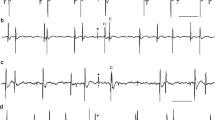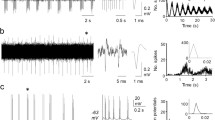Summary
Repetitive firing of motoneurones was examined in decerebrate, unanaesthetised, paralysed cats in which fictive locomotion was induced by stimulation of the mesencephalic locomotor region. Repetitive firing produced by sustained intracellular current injection was compared with repetitive firing observed during fictive locomotion in 17 motoneurones. During similar interspike intervals, the afterhyperpolarisations (AHPs) during fictive locomotion were decreased in amplitude compared to the AHPs following action potentials produced by sustained depolarising current injections. Action potentials were evoked in 10 motoneurones by the injection of short duration pulses of depolarising current throughout the step cycles. When compared to the AHPs evoked at rest, the AHPs during fictive locomotion were reduced in amplitude at similar membrane potentials. The post-spike trajectories were also compared in different phases of the step cycle. The AHPs following these spikes were reduced in amplitude particularly in the depolarised phases of the step cycles. The frequency-current (f-I) relations of 7 motoneurones were examined in the presence and absence of fictive locomotion. Primary ranges of firing were observed in all cells in the absence of fictive locomotion. In most cells (6/7), however, there was no relation between the amount of current injected and the frequency of repetitive firing during fictive locomotion. In one cell, there was a large increase in the slope of the f-I relation. It is suggested that this increase in slope resulted from a reduction in the AHP conductance; furthermore, the usual elimination of the relation is consistent with the suggestions that the repetitive firing in motoneurones during fictive locomotion is not produced by somatic depolarisation alone, and that motoneurones do not behave as simple input-output devices during this behaviour. The correlation of firing level with increasing firing frequency which has previously been demonstrated during repetitive firing produced by afferent stimulation or by somatic current injection is not present during fictive locomotion. This lends further support to the suggestion that motoneurone repetitive firing during fictive locomotion is not produced or regulated by somatic depolarisation. It is suggested that although motoneurones possess the intrinsic ability to fire repetitively in response to somatic depolarisation, the nervous system need not rely on this ability in order to produce repetitive firing during motor acts. This capability to modify or bypass specific motoneuronal properties may lend the nervous system a high degree of control over its motor output.
Similar content being viewed by others
References
Adrian ED, Bronk DW (1929) The discharge of impulses in motor nerve fibres. II. The frequency of discharge in reflex and voluntary contractions. J Physiol (Lond) 67: 119–151
Baldissera F, Gustafsson B (1971a) Supraspinal control of the discharge evoked by constant current in the alpha-motoneurones. Brain Res 25: 642–644
Baldissera F, Gustafsson B (1971b) Regulation of repetitive firing in motoneurones by the afterhyperpolarization conductance. Brain Res 30: 431–434
Barrett EF, Barrett JN, Crill WE (1980) Voltage-sensitive outward currents in cat motoneurones. J Physiol (Lond) 304: 251–276
Brownstone RM (1989) On the regulation of repetitive firing in lumbar motoneurones during fictive locomotion in the cat. University of Manitoba, Ph. D. Thesis, Winnipeg, Canada
Brownstone RM, Engberg I, Gossard J-P, Hultborn H (1991a) Voltage-dependent excitation of motoneurones from spinal centres during fictive locomotion in the cat. Soc Neurosci Abstr 17: 1028
Brownstone RM, Gossard J-P, Hultborn H (1991b) Voltage-dependency of the motoneuronal locomotor drive potentials during fictive locomotion in the decerebrate cat. J Physiol (Lond) 438:216P
Brownstone RM, Jordan LM, Kriellaars DJ, Noga BR (1987) Evidence for a spinal mechanism regulating the afterhyperpolarization amplitude in lumbar motoneurones during fictive locomotion in the cat. Soc Neurosci Abst 13: 875
Brownstone RM, Jordan LM, Kriellaars DJ, Noga BR, Shefchyk SJ (1986) Factors determining the pattern of firing in lumbar alphamotoneurones during fictive locomotion. Soc Neurosci Abst12: 877
Calvin WH (1975) Generation of spike trains in CNS neurons. Brain Res 84: 1–22
Calvin WH, Schwindt PC (1972) Steps in production of motoneuron spikes during rhythmic firing. J Neurophysiol 35: 297–310
Collingridge GL, Lester RAJ (1989) Excitatory amino acid receptors in the vertebrate central nervous system. Pharmacol Rev 41: 143–210
Coombs JS, Eccles JC, Fatt P (1955) The electrical properties of the motoneurone membrane. J Physiol (Lond) 130: 291–325
Denny-Brown D (1929) On the nature of postural reflexes. Proc R Soc Lond [Biol] 104: 252–301
Gogan P, Gustafsson B, Jankowska E, Tyc-Dumont S (1984) On reexcitation of feline motoneurones: its mechanism and consequences. J Physiol (Lond) 350: 81–91
Granit R, Kernell D, Lamarre Y (1966) Algebraical summation in synaptic activation of motoneurones firing within the ‘primary range’ to injected currents. J Physiol (Lond) 187: 379–399
Granit R, Kernell D, Shortess GK (1963a) Quantitative aspects of repetitive firing of mammalian motoneurones, caused by injected currents. J Physiol (Lond) 168: 911–931
Granit R, Kernell D, Smith RS (1963b) Delayed depolarization and the repetitive response to intracellular stimulation of mammalian motoneurones. J Physiol (Lond) 168: 890–910
Hoffer JA, Sugano N, Loeb GE, Marks WB, O'Donovan MJ, Pratt CA (1987) Cat hindlimb motoneurons during locomotion. II. Normal activity patterns. J Neurophysiol 57: 530–553
Hounsgaard J, Hultborn H, Jespersen B, Kiehn O (1988) Bistability of alpha-motoneurones in the decerebrate cat and in the acute spinal cat after intravenous 5-hydroxytryptophan. J Physiol (Lond) 405: 345–367
Hounsgaard J, Kiehn O (1989) Serotonin-induced bistability of turtle motoneurones caused by a nifedipine-sensitive calcium plateau potential. J Physiol (Lond) 414: 265–282
Ito M, Oshima T (1962) Temporal summation of after-hyperpolarization following a motoneurone spike. Nature 195: 910–911
Jodkowski JS, Viana F, Dick TE, Berger AJ (1988) Repetitive firing properties of phrenic motoneurons in the cat. J Neurophysiol 60: 687–702
Jordan LM (1983) Factors determining motoneuron rhythmicity during fictive locomotion. In: Roberts A, Roberts BL (eds) Neural origin of rhythmic movements. Symposia of the Society for Experimental Biology, Number 37. Cambridge University Press, London, pp 423–444
Jordan LM, Pratt CA, Menzies JE (1979) Locomotion evoked by brainstem stimulation: occurrence without phasic segmental afferent input. Brain Res 177: 204–207
Jordan LM, Shefchyk SJ (1984) Does the after-hyperpolarization control alpha motoneuron firing during locomotion? Soc Neurosci Abst 10: 633
Kernell D (1965a) Synaptic influences on the repetitive activity elicited in cat lumbosacral motoneurones by long-lasting injected currents. Acta Physiol Scand 63: 409–410
Kernell D (1965b) The adaptation and the relation between discharge frequency and current strength of cat lumbosacral motoneurones stimulated by longlasting injected currents. Acta Physiol Scand 65: 65–73
Kernell D (1969) Synaptic conductance changes and the repetitive impulse discharge of spinal motoneurones. Brain Res 15: 291–294
Kirkwood PA, Sears TA, Tuck DL, Westgaard RH (1982a) Variations in the time course of the synchronization of intercostal motoneurones in the cat. J Physiol (Lond) 327: 105–135
Kirkwood PA, Sears TA, Stagg D, Westgaard RH (1982b) The spatial distribution of synchronization of intercostal motoneurone in the cat. J Physiol (Lond) 327: 137–155
Kolmodin GM, Skoglund CR (1958) Slow membrane potential changes accompanying excitation and inhibition in spinal motoand interneurons in the cat during natural activation. Acta Physiol Scand 44: 11–54
Krnjevic K, Puil E, Werman R (1978) EGTA and motoneuronal after-potentials. J Physiol (Lond) 275: 199–223
Madison DV, Nicoll RA (1986) Actions of noradrenaline recorded intracellularly in rat hippocampal CA1 pyramidal neurones, in vitro. J Physiol (Lond) 372: 221–244
Nelson PG, Burke RE (1967) Delayed depolarization in cat spinal motoneurons. Exp Neurol 17: 16–26
Newton BW, Hamill RW (1988) The morphology and distribution of rat serotoninergic intraspinal neurons: an immunohistochemical study. Brain Res Bull 20: 349–360
Orsal D, Perret C, Cabelguen J-M (1986) Evidence of rhythmic inhibitory synaptic influences in hindlimb motoneurons during fictive locomotion in the thalamic cat. Exp Brain Res 64: 217–224
Perret C (1983) Centrally generated pattern of motoneuron activity during locomotion in the cat. In: Roberts A, Roberts BL (eds) Neural origin of rhythmic movements. Symposia of the Society for Experimental Biology, Number 37. Cambridge University Press, London, pp 405–422
Schmidt BJ (1990) Modulation of afterhyperpolarization amplitude in lumbar motoneurons during fictive locomotion in the rat spinal cord in vitro. Soc Neurosci Abst 16: 113
Schwindt PC (1973) Membrane-potential trajectories underlying motoneuron rhythmic firing at high rates. J Neurophysiol 36: 434–449
Schwindt PC, Calvin WH (1973a) Equivalence of synaptic and injected current in determining the membrane potential trajectory during motoneuron rhythmic firing. Brain Res 59: 389–394
Schwindt PC, Calvin WH (1973b) Nature of conductances underlying rhythmic firing in cat spinal motoneurons. J Neurophysiol 36: 955–973
Schwindt PC, Crill WE (1980) Role of a persistent inward current in motoneuron bursting during spinal seizures. J Neurophysiol 43: 1296–1318
Schwindt PC, Crill WE (1982) Factors influencing motoneuron rhythmic firing: results from a voltage-clamp study. J Neurophysiol 48: 875–890
Severin FV, Shik ML, Orlovskii GN (1967) Work of the muscles and single motor neurones during controlled locomotion. Biofizika 12: 762–772
Shapovalov AI (1972) Extrapyramidal monosynaptic and disynaptic control of mammalian alpha-motoneurons. Brain Res 40: 105–115
Shapovalov AI, Kurchavyi GG, Strogonova MP (1966) Synaptic mechanisms of vestibulospinal influences on alpha-motoneurons. Fiziol Zh SSSR 52: 91–100
Shefchyk SJ, Jordan LM (1985) Excitatory and inhibitory postsynaptic potentials in alpha-motoneurons produced during fictive locomotion by stimulation of the mesencephalic locomotor region. J Neurophysiol 53: 1345–1355
Shik MI, Severin FV, Orlovskii GN (1966) Control of walking and running by means of electrical stimulation of the mid-brain. Biofizika 11: 659–666
Van Dongen PAM, Grillner S, Hökfelt T (1986) 5-Hydroxytryptamine (serotonin) causes a reduction in the afterhyperpolarization following the action potential in lamprey motoneurons and premotor interneurons. Brain Res 366: 320–325
Zajac FE, Young JL (1980) Discharge properties of hindlimb motoneurons in decerebrate cats during locomotion induced by mesencephalic stimulation. J Neurophysiol 43: 1221–1235
Author information
Authors and Affiliations
Rights and permissions
About this article
Cite this article
Brownstone, R.M., Jordan, L.M., Kriellaars, D.J. et al. On the regulation of repetitive firing in lumbar motoneurones during fictive locomotion in the cat. Exp Brain Res 90, 441–455 (1992). https://doi.org/10.1007/BF00230927
Received:
Accepted:
Issue Date:
DOI: https://doi.org/10.1007/BF00230927




